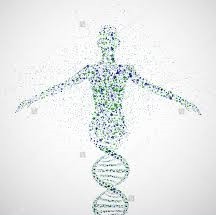DNA's polar pirouette: A spiral stair orbiting its own anti-axis

Just as bio-poetics (as the paraverbal use of living materials) is a creative genre serving as a materials-research discipline, our DNA’s twisting double-helix is a life-maintaining chemical template frequently recruited to serve as a literary icon. Dense with symbolic possibilities, the ten-step spiral stair of a DNA molecule is like five pairs of couplet rhyme, its floors are figurative “stories” divided by crossbar ribs made of ribose sugars, a geometric trellis supporting (by spelling out) the flesh and foliage of organic Life.
DNA’s twist is almost literally poetic: the word “prose” derives from the Latin prosa for direct and linear, but “verse” from versum means pivoting and turning. Its helix is an archive whose storage is a matter of Surge instead of Stasis. Its sugar-phosphate backbone resembles a book’s bound spine or a Rolodex’s turning spindle. In terms of bookish metaphor, DNA is a how-to manual, a double-stranded memoir, and a speculative semi-fiction. These figurative similarities between the living and the literary, when empirically acted upon, suggest provocative vistas for the manipulation of biological matter.
One can also map out an index of correspondences between poetic genres and key moments in genetic science. Imagism, and its emphasis on furtively glimpsed objects, emerged as the orbital model of the atom debuted in 1914, ushering in a newly quantum view of genetic matter as a probable swirl. Ezra Pound’s Vorticism (and its insignia of the Vortex as a spiraling figure of torque and power) eventually gained canonical academic status at the same time that geneticists were decoding the DNA helix. In his gnomic fragment “An Object,” Pound refers to an item composed of “a code and not a core,” indirectly looking forward to a quantum, digital genetics. Lettrism achieved a certain revival in avant-garde verse in the post-WWII era, paralleling research into amino-letters as our anatomic building blocks. So-called “Language” poetry (by vexing and defying “organic” speech cadences) troubles the notion of a naturally present, reliable speaker behind a poem while the Human Genome Project is busy “reducing” our human form to a recipe of chemical inputs.
When bio-poets ranging from Eduardo Kac to Joe Davis to Christian Bök insert poetic code into a living cell, they cast new illuminations on poetry-as-genre and metaphor-as-operation. The very process of metaphor as an oscillating figure between objects of comparison is microcosmically illustrated by our most fundamental genetic actions. As DNA self-replicates it projects its negative image (as an inverted template) on its own surface, swapping chromosomal cause and enzymatic effect in a rapid shuttle. Similarly, the dualistic, tenor-and-vehicle model of metaphor has long been in question: instead of a simple binary, such literary method is more often a spiraling interaction with several facets at play.
In Representative Men, Emerson refers to Descartes’ take on the Spiral and its self-rotating polarity as nature’s main motion. Kinetically, we speak words from a throat spirally grooved like a rifle barrel, and wield a pen (and tap a keyboard) with fingertips spiraled with whirlpools mirroring and manifesting our inner metabolism. To spiral is to wed a progressive line to a recurring part-circle, and so to partake of linear time and to partially subvert such linearity at once. Similarly, our DNA is both the main engine of our species’ “progress” and the main means of genetic self-tinkering.
This conical, rotating geometry also applies to the act of composition itself. The writing wrist, operating on a principle of pivoting torque, forms its cursive letters in spiraling gestures of cubital and radial slopes. Bio-poetics often aspires to an even more looping and less linear mode of expression. Eduardo Kac’s hologram-projected poems spin around a reader’s head like asteroid loops—Kac writes of one such poem operating “as if the vowel were the atomic nucleus and the consonants were the particles orbiting around it.” This disassembled projection of a linear word into holographic space suggests that bio-poetics is equally concerned with language as tangible matter and such matter as a product of abstract code.
The self-“reading” process of DNA (in which the two sides of the double helix scan one another for content) is itself a metaphor that breeds further metaphors. In his visionary tome The Seven Mysteries of Life, Guy Murchie compares the procedure to a linotype machine, a player piano, a digitally upraised Braille, and a typist whose mutant misprints accumulate into new vistas in our species grammar. The acronym “DNA” is English’s primary connective—“and”—suitably rotated on its n-axis. DNA’s spiral dance is a momentary self-scissoring followed by re-assembly, a double-axel maneuver and a cable-knit corkscrew, unzipping and re-suturing as it renders itself halved and incomplete and then entwined and renewed. All of this is achieved in a hectic-yet-timeless four-digit two-step that resembles a lyre restringing its own guts to an unheard music.
A p.s. to Genesis: notes on transgenic/bio-poetic art